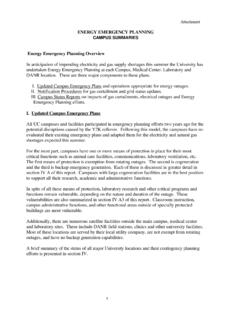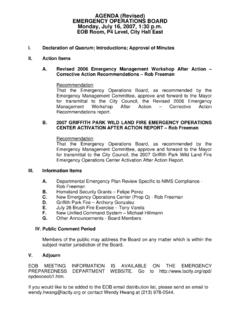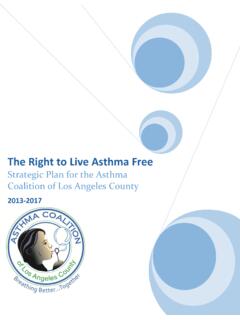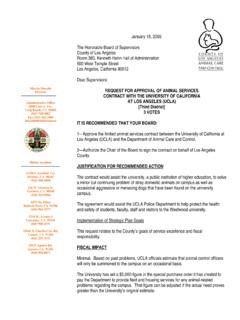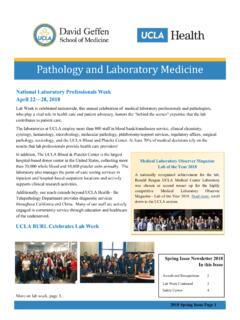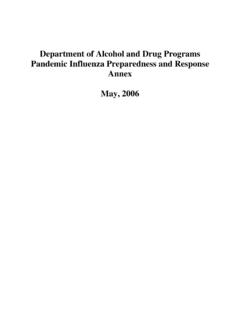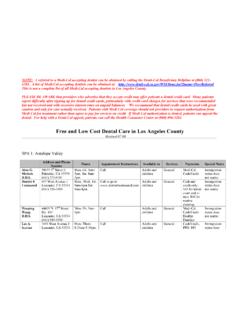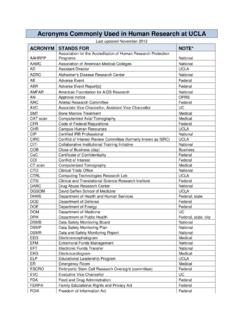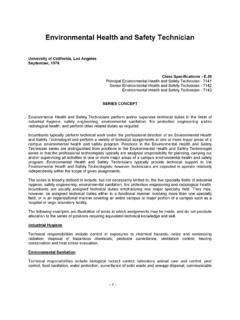Transcription of Cyclotron & Radiochemistry: Operational ... - crump.ucla.edu
1 Cyclotrons & RadiochemistryDavid Stout PhDTopics Cyclotrons:How to accelerate protons Cyclotrons:Targetry, making radioactive atoms Radiochemistry: Half life limitations, Chemistry in a box Safety:Radioactive, chemical, electrical, mechanical issues Operational Consideration:logs, stack monitoring, usage, transfer records, access & personnel Visual Tour: Installation & systemsTopics Cyclotrons:How to accelerate protons Cyclotrons:Targetry, making radioactive atoms Radiochemistry: Half life limitations, remote operations Safety:Radioactive, chemical, electrical, mechanical issues Operational Consideration:logs, stack monitoring, usage, transfer records, access & personnel Visual Tour.
2 Installation & systemsAccess Access to all spaces requires a CNSI photo ID card Entry authorization granted for Cyclotron and imaging areas following review of this training material ANDa facility tour with one of the lab supervisors (David, Jeff or Waldy) Entry authorization for vivarium comes from DLAM only after meeting all vivarium requirements Appropriate clothing always required, no exposed skin below the waist, closed shoes Lab coat and ID badge required for all spacesReporting ProblemsIf there are any problems, report them to the imaging center staff and your faculty member. Contact information is also on fire diamond cards on each Center Oversight:David Stout x72646 Area:Jeffrey Collins Area:Waldemar Ladno x42224 Williams x42224 Contact Numbers DLAM: Vivarium Facility emergency contact pager at 98714.
3 For problems related to animal health, please page either the on call veterinary technician (pager 94513) or the on call veterinarian (pager 96545) for assistance ARC Phone: (310) 206 6308 email: EHS (RSO & Biosafety): Phone: (310) 825 5689| Fax: (310) 825 7076| EH&S Hotline: (310) 825 9797 Occupational Health: Occupational Health Facility Westwood10833 Le Conte Ave, Room 67 120 CHS Los Angeles, CA 90095 (310) 825 6771 Mon Fri 7:00 am 4:30 pmGlove Use Gloves are only for immediate handling of chemicals, radiation and animals Gloves cannot be worn outside the room where you put them on, no gloves in hallways or touching door handles Glove cannot touch doors, cabinets, computers, pens, notebooks, or be on hands in your pockets Consider anything touched by a glove to be potentially hazardous; don t touch anything others would handle while not wearing glovesRadiation Safety:You should know to answer these questions: What is ALARA?
4 How is radiation stored in the lab, wastes? What are the hazards of the isotope you use? Where do you get information about radiation use and policies? What training is required, initial and ongoing? How is radioactive material labeled? What do you do in an emergency ? How do you use radioactivity monitoring equipment? What techniques do you use to reduce exposure?Personnel Requirements Must have lab coat used only for radioactive work Must wear film badge and finger rings No exposed skin below the waist, closed shoes Wear gloves only when handling radiation, remove all other times. No gloves on in hallways and they should never touch doors, pens, meters, drawers or keyboards.
5 If a glove is needed to hold something for transport, use secondary containment. Always have a meter on and check yourself, your surroundings and your work area before, during and after your work Notify others in your work area of radiation usePersonnel All personnel working in the Cyclotron area must be radiation workers and trained in appropriate use and monitoring of radioactive materials Safety training is mandatory, both for initial training and as an ongoing program People must know what to do in the event of an accident, who to notify and how to properly document actions Only licensed operators are allowed to operate the Cyclotron according to the UCLA CA radiation license agreementRadiochemistry Hazards Primary hazard is radiation.
6 Up to 4 Ci may be present Secondary hazard is chemical exposure to reagents Mechanical hazards: hot cell doors, tripping hazards, heavy equipment May be electrical hazards from switches, power supplies, cables Gas tanks must be secured, heavy, potential missile if valve is sheared Proper monitoring equipment required for radiation Stack monitoring must be observed to note radiation releases Know where first aide kits and eye wash stations are located Do not work aloneInternal versus External Exposure Internal exposure from ingested or implanted activity is much more damaging than external sources because of short distance, long exposure time and no shielding.
7 PET isotopes have both charged particle beta exposure (positron) and gamma radiation. Positron dose is all deposited locally (<1 mm), and causes more damage since it is an ionizing charged particle. Gamma radiation causes exposure to a much larger area and is harder to shield. Others in the room may be subject to exposure. No food or drink allowed to minimize risk of internal exposureThings NOT to have in the Lab No Drink No Food or gum Don t Smoke No cosmeticsAnnual Radiation Dose LimitsPopulationWhole BodyExtremityRadiation Workers5 rem/yr50 rem/yrGeneral rem/yr5 rem/yrUCLA requires action if whole body dose exceeds R/yrRadiation Dose NotificationsALARA IALARA IIALARA IIIW hole Body100 mrem 300 mrem 500 mremExtremity100 mrem 1000 mrem 5000 mremIf you reach any of these alarm levels.
8 Immediately notify your may be ways to reduce your exposure that should be Warning SignsCyclotron VaultRadiochemistry RoomQC LabPET/CT Imaging AreaRadiolabeling LabDose drawing roomWarning IndicatorsDoors are labeled with safety information, including the fire diamond and radioactivity warning. Vivarium doors have a negative pressure indicator, where a red ping pong ball is visible if pressure is not pressure indicatorSafety Diamond with emergency contact numbersRadiation MetersUse meters to survey for activity. Always have a pancake meter on when using activity to survey your gloves. Use exposure meter to measure activity field strength.
9 Exposure meter:Activity level mRPancake Meter Activity: yes/noMeter Operation Check Always have a GM meter on when working with radiation Turn meters OFF when not in use Operation/Battery check with each use Annual calibrationMeasures to Reduce Personnel Dose ALARA: As Low As Reasonably Achievable Time, Distance, and Shielding plan your experiments! Laboratory Technique Administrative and Procedural ControlsMinimize Time: Practice Practice what you plan to do first, without radioactivity if at all possible Measure radioactivity field first, decide how much time a quick fix requires and estimate your exposure before going into the hot cell If exposure is unavoidable (servicing hot parts)
10 , walk through the process first to know exactly what you need and how to do it, review SOPs Sometimes experiments need to fail, do not take unnecessary dose and risks for something that can be tried again laterRadiation Safety Handling Activity Wear gloves, lab coast, film and ring badges Use remote handling devices whenever possible Notify others in the room if activity will be outside of shielding Minimize time of exposure; think about how and what you will do first Handling >200 mCi is unsafe; use remote tools Opening hot cells when high amounts of activity are present is unsafe, leave door closed.
